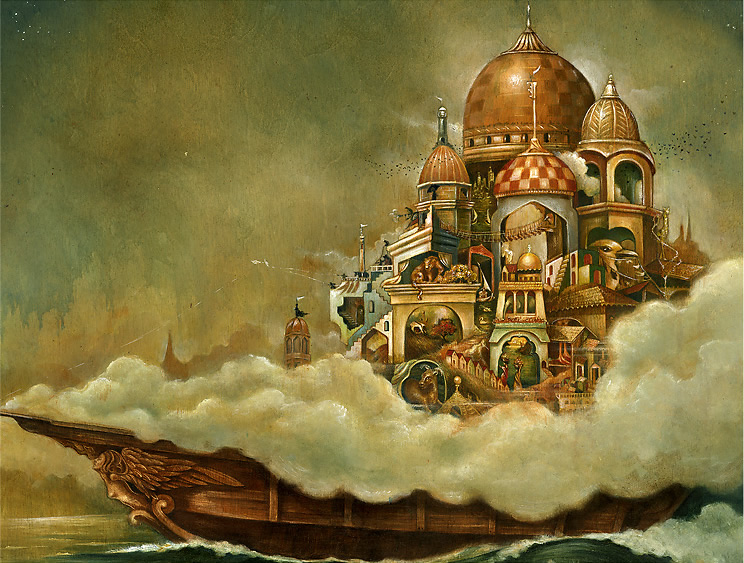

This was a very fluid and creative process, and trying out one thing led to another. I assembled my visual research, reference and doodles and started to collage and draw a thumbnail of what I was trying to achieve in response to the key words and phrases in the text. It meant that I didn’t have to tackle visually describing too much of the city itself which I would choose to do in a completely different way.The huge sweeping scale and visual hierarchy leads the viewer from the clouds in the foreground, across and along the sweeping curve of the rope bridge and up to spider web city hanging between twin peaks.I wanted to create a sense of height and precariousness.The reason for choosing this approach was threefold: I decided that I’d meet the ‘sense of depth requirement’ in the brief by creating an epic scale view. This phase was an interesting and fairly slow process that happened over a couple of weeks alongside other exercises and reading the book. Precipice between two steep mountains: the city is over the voidĭoodle 06 – Several thumbnails trying out different compositions including the one that was developed further.The key descriptive words and passages from the test I was responding to included: In parallel with my research I doodled ideas in an A5 sketchbook of anything that came to mind referring to my iPhone for googled reference materials/images. The huge threatening monster and the small innocence of the child. Part of the power of the images is how they play with the idea of scale. Like Invisible Cities the artist is having to illustrate and communicate an abstract or imagined subject. The images have a print like quality, a mixture of monoprint and etching and have a raw dark energy. There are so many things I like about the illustrations he did for A Monster Calls by Patrick Ness. I then came across the work of Jim Kay in Understanding Illustration, Derek Brazell and Jo Davies published by Bloomsbury. I spent a bit of time looking at the work of illustrators creating work for science fiction and fantasy subjects but that didn’t grab my attention. My second area of research was to look for other illustrators that used their work to describe abstract or imagined worlds. An alternative approach would have been to use a more allegorical or abstract method to describe the city. Initial sketch and collage using an illustrated picture frame in the style of an illuminated manuscript from 13th century to introduce the two protagonists in the book to the viewerĪn important aspect that framed my response to the brief was the need to reflect the visual depth portrayed in the writing which is why I chose to create an image with a visual space using conventional perspective.

I doodled some thoughts in an A2 sketchbook. I wondered if there was a way to include some aspect of the overall framing narrative of the book into the illustration. My first area of research was to briefly review the lives of the two characters to see if there was any information that would help frame the work. Octavia, the name of the city that is the subject of this brief appears about two thirds of the way through.Īlthough the dialogue is between two characters from the 13th Century the description of the cities include contemporary reference, so the time location of the book in time is ambiguous.Īfter the reading the book I had two lines of enquiry. These are occasionally interspersed with dialogue between the two characters. The book contains a description of 55 different cities, each one described in a mini chapter. The Khan is overseeing rapid expansion of his vast empire, and as part of this he listens to accounts and descriptions of faraway cities from his officials. It’s centred around a conversation between two characters, the Kublai Khan and Marco Polo. I found it a strange slightly surreal book. The first thing I did was to read the novel. In keeping with most of the book, Thin Cities 5 is an evocative description of a made-up world that is open-wide for visual interpretation. I found the brief an excellent challenge. Illustrator’s work that has influenced your thinking.Explaining why you chose your particular image making approach.Reflect the visual depth portrayed in Calvino’s writing.The purpose of the assignment was to produce an illustration that visually responds to extract from Italo Calvino’s 1972 novel Invisible Cities


 0 kommentar(er)
0 kommentar(er)
